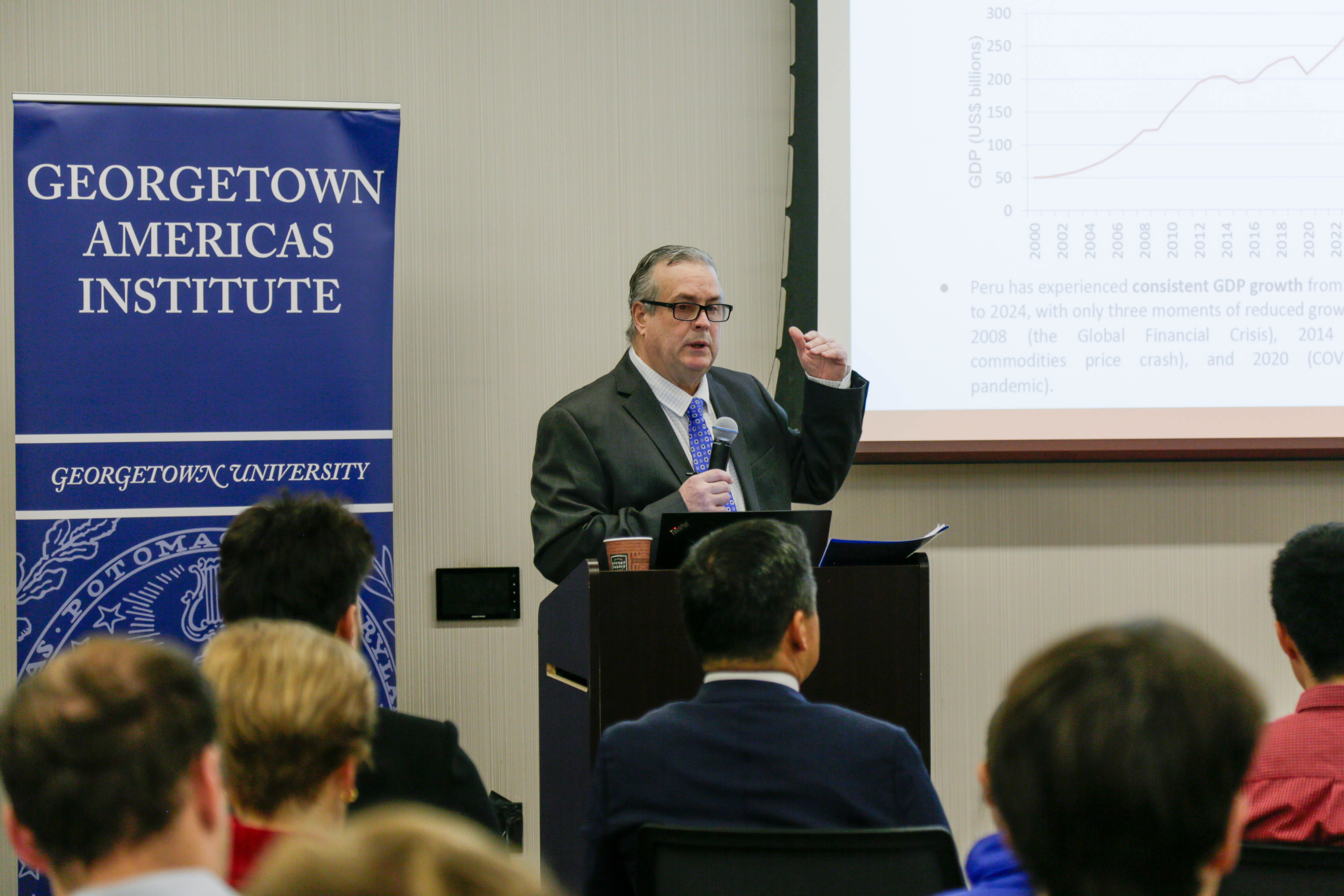A Conversation with Peruvian Ambassador Alfredo Ferrero
On January 30, 2025, the Georgetown Americas Institute hosted Alfredo Ferrero, Peruvian Ambassador to the United States, to discuss Peru's growing strategic importance in Latin America and its economic relationship with the United States. The conversation, moderated by Denisse Yanovich, the Institute's Managing Director, focused on the key sectors driving Peru's steady growth, its infrastructure needs, and the future of US-Peru relations in light of global shifts in economic partnerships.

As the fourth largest country in Latin America and the Caribbean, Peru is central to the region's trade networks. Positioned on the South Pacific Ocean, Peru borders five countries and serves as a logistical hub for regional and international trade. Recently, the inauguration of the Port of Chancay, financed through Chinese investments and other strategic ports, continues to strengthen Peru's capacity to facilitate trade. Despite periods of political instability, the country has maintained its economic momentum, experiencing consistent GDP growth over the past 30 years, barring the setbacks caused by the COVID-19 pandemic. Ambassador Ferrero discussed these issues with Georgetown students and faculty.
Peru's Economic Growth and Key Infrastructure Projects
Ambassador Ferrero stressed that Peru's economic projections are strong, with a growth rate of 3.1% in 2024 and the highest growth forecast in Latin America and the Caribbean (LAC) for 2025 to 2028. Additionally, Ferrero emphasized that the country's stable currency is supported by Peru's international reserves, which make up 30% of GDP, higher than the region's average of 14.5%. Peru's public debt stands at 32.9%, well below the regional average of 73.7%, and the fiscal deficit is 3.6% of GDP, compared to 6% for the region.
Key to these projections are ongoing infrastructure projects that are driving the country's modernization. Notable projects include the Jorge Chávez International Airport, the Port of Callao, the Port of Chancay, and large-scale mining operations at Yanacocha and Cerro Verde. Ferrero mentioned that the government remains focused on improving infrastructure and competitiveness to support long-term growth, alongside attracting foreign investment.
"We need to establish our country as a strategic partner for global growth and regional trade"
Core Sectors Driving Peru's Growth
Four key sectors—agriculture, mining, fisheries, and tourism—drive Peru's economic growth. Agriculture, in particular, plays a vital role, with the country exporting over $12 billion in agricultural products each year. Mining, one of the most critical sectors, is vital to the nation's economy. Peru is home to eight out of seventeen critical minerals identified by the U.S. as essential for the transition energy area, i.e., Vehicle Electrification. Peru is also a global leader in the fisheries sector, representing 4.5% of total exports, particularly in fishmeal and fish oil production, which generate more than $3 billion in revenue. The last sector, tourism, continues to grow as millions visit the country each year to connect with Peru's archeological heritage and cuisine.
Trade Partnerships
Ambassador Ferrero emphasized the significance of Peru's extensive network of trade agreements, to which he attributes the country's success. With 22 active trade agreements, Peru can access 58 destinations, including major economies such as Canada, Mercosur, the United States, Mexico, and the European Union. These agreements cover nearly all of Peru's exports, such as copper, lithium, textiles, and agricultural products like blueberries, making trade a central driver of the country's economic success.
To build up its trade portfolio, Peru recently signed a Free Trade Agreement with Hong Kong on November 15, 2024, during the APEC Summit in Lima. Ambassador Ferrero noted, "We don't look at politics; we look at numbers," emphasizing that Peru's trade priorities are rooted in economic opportunities rather than political considerations.
"One of the key elements for our 30 years of growth is because of trade agreements.”
Investment Gaps and Opportunities
Despite Peru's steady economic growth, the country still faces a substantial infrastructure gap estimated at around $140 billion. Ambassador Ferrero mentioned that closing this gap is critical to reducing export times and enhancing the country's competitiveness on the global stage. Additionally, he mentioned that adressing this gap and in turn enhancing critical sectors it will improve their connectivity between remote populations and export more products globally.
This infrastructure deficit presents substantial opportunities for foreign and domestic investors, especially in the energy, logistics, and infrastructure sectors. As Ambassador Ferrero highlighted, "This gap is a deficit we have to cleverly address. We need foreign investment and are open to companies from around the world to come to Peru and help us reduce this gap—not just in ports, highways, and electricity, but across various critical sectors."
During the Q&A portion of the event, students asked questions related US-Peru relationship amid current geopolitical tensions with China, to which the Ambassador responded that Peru has a stronger relationship with the US with diversified exports and security cooperation agreements.
